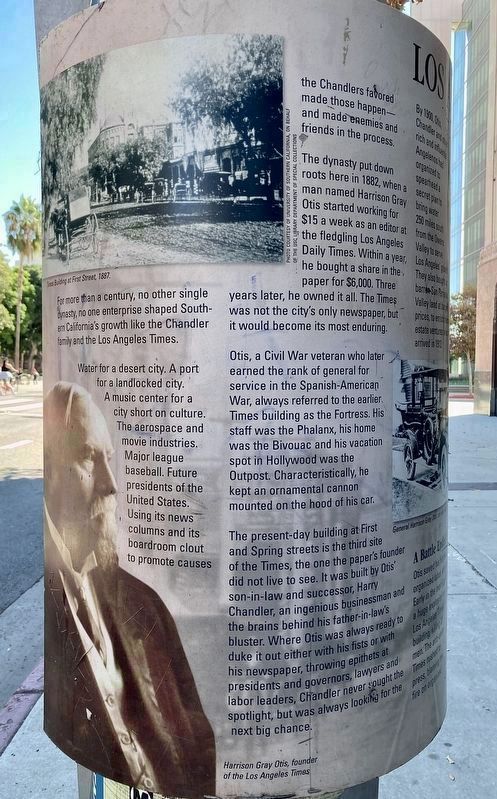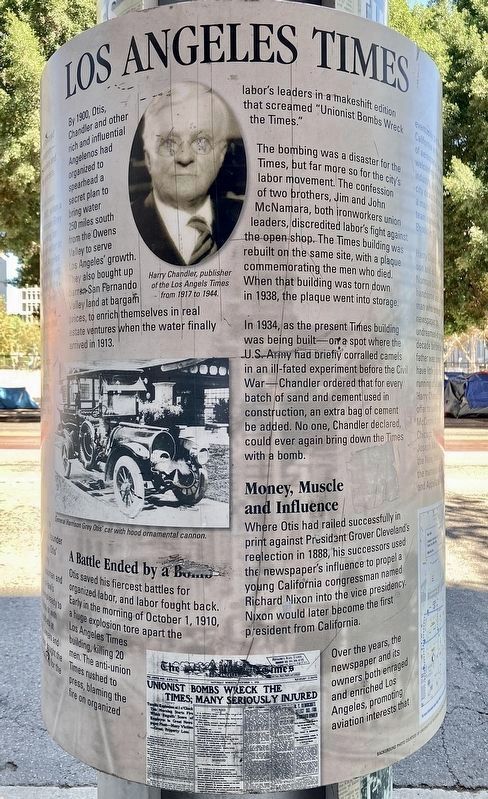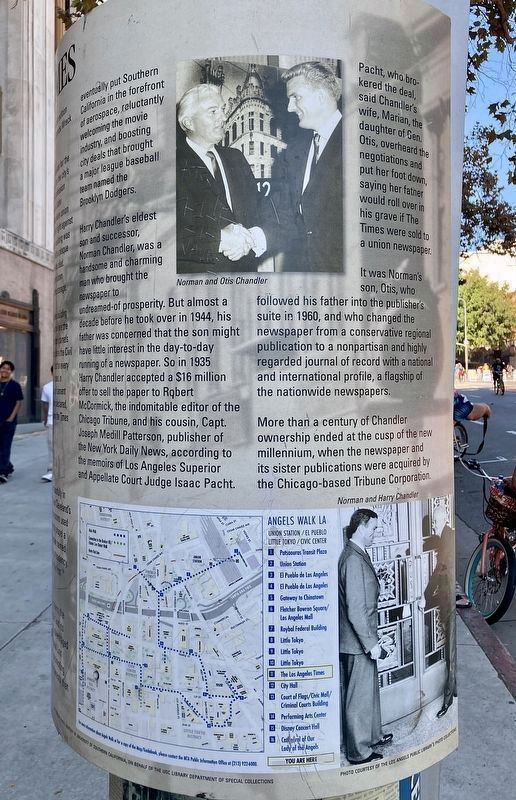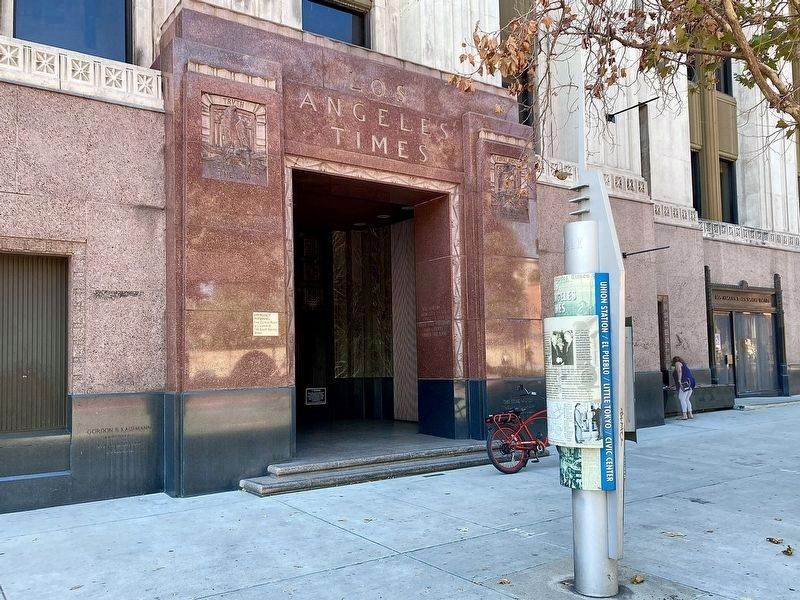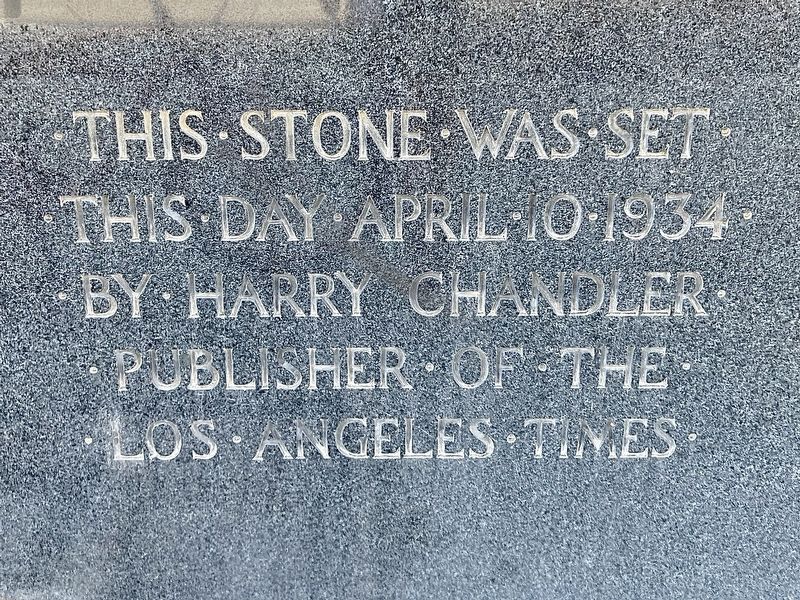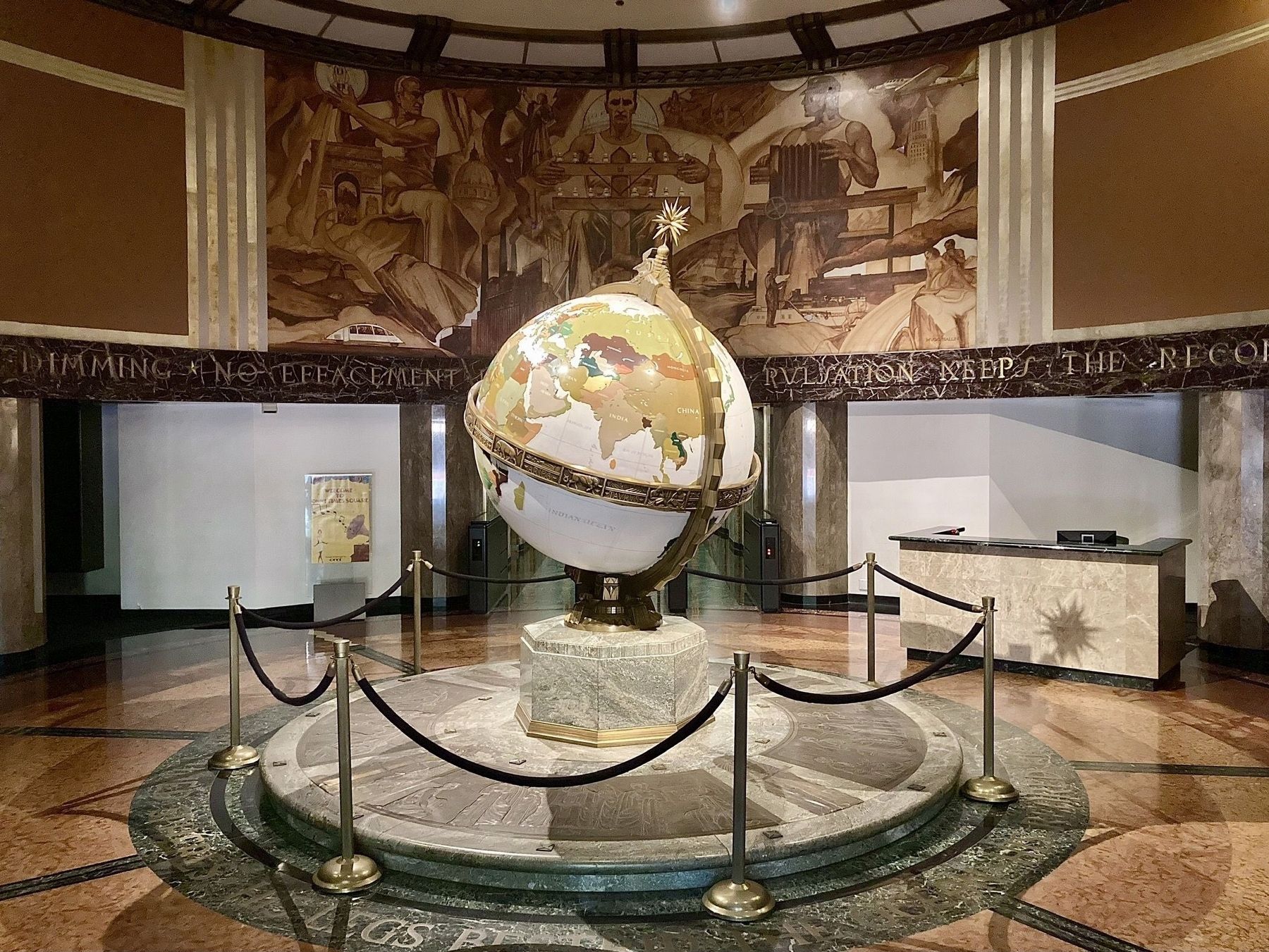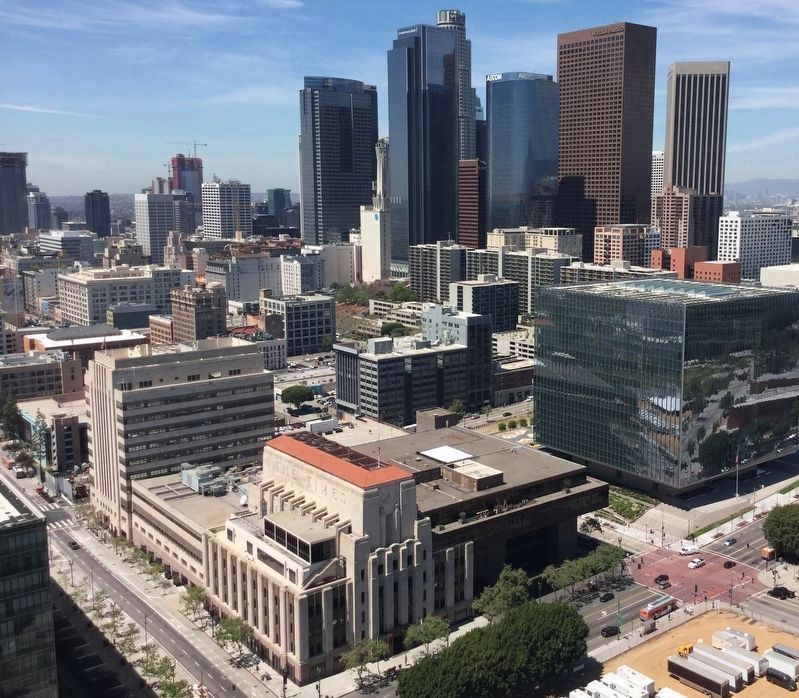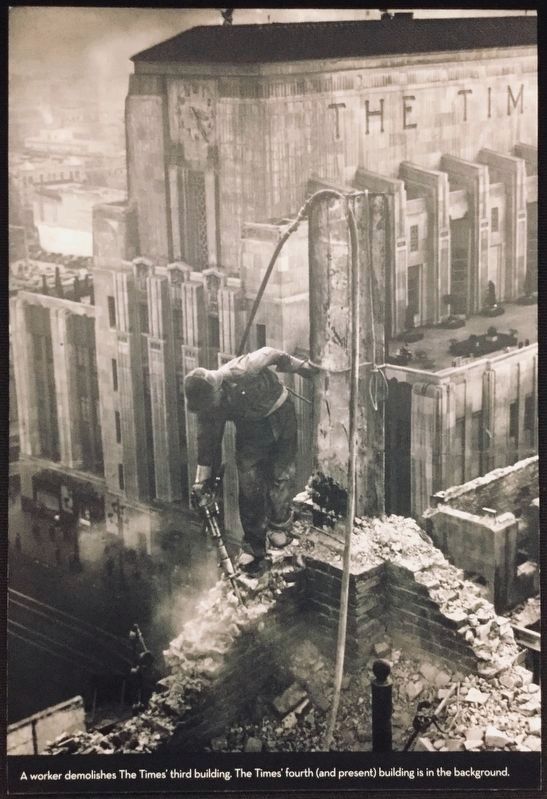Downtown Los Angeles in Los Angeles County, California — The American West (Pacific Coastal)
Los Angeles Times
For more than a century, no other single dynasty, no one enterprise shaped Southern California's growth like the Chandler family and the Los Angeles Times.
Water for a desert city. A port for a landlocked city. A music center for a city short on culture. The aerospace and movie industries. Major league baseball. Future presidents of the United States. Using its news columns and its boardroom clout to promote causes the Chandlers favored made those happen — and made enemies and friends in the process.
The dynasty put down roots here in 1882, when a man named Harrison Gray Otis started working for $15 a week as an editor at the fledgling Los Angeles Valley Daily Times. Within a year, he bought a share in the paper for $6,000. Three years later, he owned it all. The Times was not the city's only newspaper, but it would become its most enduring.
Otis, a Civil War veteran who later earned the rank of general for service in the Spanish-American War, always referred to the earlier Times building as the Fortress. His staff was the Phalanx, his home was the Bivouac and his vacation spot in Hollywood was the Outpost. Characteristically, he kept an ornamental cannon mounted on the hood of his car.
The present-day building at First and Spring streets is the third site of the Times, the one the paper's founder did not live to see. It was built by Otis' son-in-law and successor, Harry Chandler, an ingenious businessman and the brains behind his father-in-law's bluster. Where Otis was always ready to duke it out either with his fists or with his newspaper, throwing epithets at presidents and governors, lawyers and labor leaders, Chandler never sought the spotlight, but was always looking for the next big chance.
By 1900, Otis Chandler and other rich and influential Angelenos had organized to spearhead a secret plan to bring water 250 miles south from the Owens Valley to serve Los Angeles' growth. They also bought up barren San Fernando Valley land at bargain prices, to enrich themselves in real estate ventures when the water finally arrived in 1913.
A Battle Ended by a Bomb
Otis saved his fiercest battles for organized labor, and labor fought back. Early in the morning of October 1, 1910, a huge explosion tore apart the Los Angeles Times building, killing 20 men. The anti-union Times rushed to press, blaming the fire on organized labor's leaders in a makeshift edition that screamed "Unionist Bombs Wreck the Times."
The bombing was a disaster for the Times, but far more so for the city's labor movement. The confession of two brothers, Jim and John McNamara, both ironworkers union leaders, discredited labor's fight againt the open shop. The Times building was rebuilt on the same site, with a plaque commemorating the men who died. When that building was torn down in 1938, the plaque went into storage.
In 1934, as the present Times building was being built — on a spot where the U.S. Army had briefly corralled camels in an ill-fated experiment before the Civil War — Chandler ordered that for every batch of sand and cement used in construction, an extra bag of cement be added. No one, Chandler declared, could ever again bring down the Times with a bomb.
Money, Muscle, and Influence
Where Otis had railed successfully in print against President Grover Cleveland's reelection in 1888, his successors used the newspaper's influence to propel a young California congressman named Richard Nixon into the vice presidency. Nixon would later become the first president from California.
Over the years, the newspaper and its owners both enraged and enriched Los Angeles, promoting aviation interests that eventually put Southern California in the forefront of aerospace, reluctantly welcoming the movie industry, and boosting city deals that brought a major league baseball team named the Brooklyn Dodgers.
Harry Chandler's eldest son and successor, Norman Chandler, was a handsome and charming man who brought the newspaper to undreamed-of prosperity. But almost a decade before he took over in 1944, his father was concerned that the son might have little interest in the day-to-day running of a newspaper. So in 1935 Harry Chandler accepted a $16 million offer to sell the paper to Robert McCormick, the indomitable editor of the Chicago Tribune, and his cousin, Capt. Joseph Medill Patterson, publisher of the New York Daily News, according to the memoirs of Los Angeles Superior and Appellate Court Judge Isaac Pacht. Pacht, who brokered the deal, said Chandler's wife, Marian, the daughter of Gen. Otis, overheard the negotiations and put her foot down, saying her father would roll over in his grave if The Times were sold to a union newspaper.
It was Norman's son, Otis, who followed his father into the publisher's suite in 1960, and who changed the newspaper from a conservative regional publication to a nonpartisan and highly regarded journal of record with a national and international profile, a flagship of the nationwide newspapers.
More than a century of Chandler ownership ended at the cusp of the new millennium, when the newspaper and its sister publications were acquired by the Chicago-based Tribune Corporation.
Erected 2000 by City of Los Angeles. (Marker Number 1174.)
Topics and series. This historical marker is listed in these topic lists: Architecture • Industry & Commerce • Labor Unions. In addition, it is included in the Los Angeles Historic-Cultural Monument series list. A significant historical year for this entry is 1882.
Location. 34° 3.186′ N, 118° 14.692′ W. Marker is in Los Angeles, California, in Los Angeles County. It is in Downtown Los Angeles. Marker is at the intersection of 1st Street and Spring Street, on the right when traveling east on 1st Street. Touch for map. Marker is at or near this postal address: 214 W 1st St, Los Angeles CA 90012, United States of America. Touch for directions.
Other nearby markers. At least 8 other markers are within walking distance of this marker. Los Angeles City Hall (about 400 feet away, measured in a direct line); Historical Site (about 500 feet away); a different marker also named Los Angeles City Hall (about 600 feet away); The Lindbergh Beacon (about 600 feet away); Higgins Building (about 700 feet away); Vietnam Memorial (about 700 feet away); St. Vibiana’s Cathedral (approx. 0.2 miles away); Fletcher Bowron Square (approx. 0.2 miles away). Touch for a list and map of all markers in Los Angeles.
Regarding Los Angeles Times. This was the newspaper’s third location, and its fourth building. The second building (1887–1910), located on the northwest corner of 1st and Broadway, is the building that was destroyed in the deadly Los Angeles Times bombing of 1910. The third building (1912–1934), was built on the same site.
The fourth building (1935–2018), at 214 W First Street - the original structure on the southwest corner of 1st and Spring was designed by Gordon Kaufmann. Eventually the Times expanded to fill the whole block as Times Mirror Square, bounded by 1st, 2nd, Spring and Broadway. Later Times Mirror Square additions included the 1948 Rowland H. Crawford expansion, the 1973 William Pereira addition, and a parking structure.
Declared Los Angeles Historic-Cultural Monument No. 1174 in 2018. This block is California Historical Landmark No. 744 — “The Mirror Building (site of Butterfield Stage Station).”
The newspaper moved to a new headquarters building in El Segundo, near Los Angeles International Airport, in July 2018.
This block is the site of:
First brick school house in Los Angeles known as School No. 1, built 1854-1855;
Butterfield Overland Mail Company office and corral, 1858-1861;
Office of U.S. Quartermaster, 1861;
Corral for camels from Fort Tejon, 1861;
and Los Angeles City Hall, built 1884.
On January 19, 2018, employees of the news department voted 248–44 in a National Labor Relations Board election to be represented by the NewsGuild-CWA. The vote came despite aggressive opposition from the paper's management team, reversing more than a century of anti-union sentiment at one of the biggest newspapers in the country.
Related marker. Click here for another marker that is related to this marker. — The Army camels experiment which ended here in 1861.
Also see . . . Angels Walk L.A. Self-guided walking tours of historic neighborhoods in Los Angeles. The Los Angeles Times marker is part of the Union Station walk. (Submitted on October 18, 2023.)
Credits. This page was last revised on January 5, 2024. It was originally submitted on October 18, 2023, by Craig Baker of Sylmar, California. This page has been viewed 98 times since then and 30 times this year. Photos: 1, 2, 3, 4, 5, 6. submitted on October 18, 2023, by Craig Baker of Sylmar, California. 7. submitted on July 13, 2018, by Craig Baker of Sylmar, California. 8. submitted on July 12, 2018, by Craig Baker of Sylmar, California.
